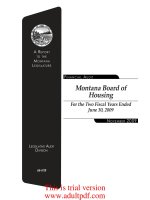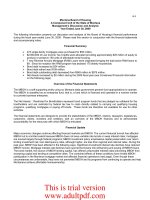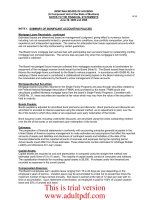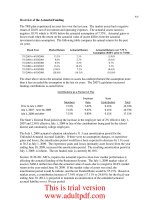A REPORT ARIZONA LEGISLATURE TO THE Financial Audit Division Special Financial Audit_part2 ppt
Bạn đang xem bản rút gọn của tài liệu. Xem và tải ngay bản đầy đủ của tài liệu tại đây (147.28 KB, 15 trang )
agencies and local jurisdictions for individual projects until August 30, 2006,
which was in accordance with the requirements established by the DHS.
However, this was not in time for auditors to include the specific project’s goals
and objectives in this report. Arizona did receive the Emergency Management
Performance Grants from the DHS in February 2006, and allocated these
monies between the State and counties. Auditors did not include the specific
allocations made for the 2006 Emergency Management Performance Grants in
this report to ensure that consistent information is presented for all grant year
2006 programs.
For grant year 2006, information regarding the amount awarded to the State for
each program, and the monies the AOHS and the ADEM allocated between the
State and the local jurisdictions (in total) for each program, was available and is
included in the report.
z For grant years 2003 through 2005 the AOHS and the ADEM awarded monies
for approximately 450 homeland security projects to about 200 state agencies
and local jurisdictions. Auditors performed detailed test work on a sample of 58
program expenditures during the fiscal year 2005 single audit for the State of
Arizona to determine the allowability of project expenditures. These expenditures
were selected from the grant year 2003 and 2004 State Homeland Security
Program, the grant year 2004 Citizens Corps Program, and the grant year 2004
and 2005 Emergency Management Performance Grants. Auditors reported no
unallowable expenditures as a result of this test work; however, auditors
reported weaknesses in the internal controls established to administer the
homeland security grant programs. The weaknesses noted are mentioned in
Chapter 4 of this report.
The Auditor General and staff express their appreciation to the Director of Homeland
Security, the Department of Emergency and Military Affairs Adjutant General, and the
staff of the Arizona Governor’s Office of Homeland Security and the Arizona
Department of Emergency and Military Affairs, Division of Emergency Management
for their cooperation and assistance during this audit.
Office of the Auditor General
page 7
This is trial version
www.adultpdf.com
State of Arizona
page 8
This is trial version
www.adultpdf.com
Administration of Arizona’s Homeland Security
Grant Program
The State’s Director of Homeland Security is appointed by the Governor and is
responsible for managing the AOHS and the ADEM. Both the AOHS and the ADEM
are responsible for administering Arizona’s Homeland Security Grant Program. The
AOHS is primarily responsible for the overall planning and coordination of the State’s
homeland security efforts and the ADEM is responsible for performing the
administrative functions necessary to manage the Program. Federal regulations
allow the AOHS and the ADEM to incur costs for planning and organization,
equipment, training, exercises, and management and administration.
Homeland Security Director’s responsibilities
The Director of Homeland Security was appointed by the Governor in
February 2003 and serves as the director of both the AOHS and the
ADEM. Overall, the Director is responsible for leading Arizona’s
homeland security and emergency management efforts. As the
Director of the AOHS, he is responsible for ensuring that Arizona is
safe from terrorism and that protocols are established with federal,
state, and local agencies in the event of terrorist activity or other
emergencies. He is also responsible for developing and executing the
State’s homeland security strategy. As director of the ADEM, he is
responsible for coordinating a multiple-agency response to large-
scale disasters in Arizona. Table 1 shows the Director’s salary
received for each fiscal year since 2003. In addition, prior to his
employment with the State, he received $8,000 for consulting services
on matters pertaining to homeland security performed in January
2003. From fiscal year 2003 through fiscal year 2006, the Director did
not hold any additional positions in state government that added to
his salary.
Office of the Auditor General
page 9
CHAPTER 1
Fiscal
Year
Salary
Received
2003
1
$ 37,424
2004
115,083
2005
124,847
2006
129,635
Table 1: Director’s Salary
(Unaudited)
1
The Director was appointed in February
2003.
Source: Auditor General staff analysis of fiscal years
2003 through 2006 information obtained from
the State of Arizona Human Resources
Management System and the Human Resource
Information Solution System.
This is trial version
www.adultpdf.com
Arizona Office of Homeland Security responsibilities
The AOHS is responsible for planning and coordinating homeland security efforts
among state, federal, local, tribal, and border community agencies and entities. In
addition, the AOHS advises the Governor on all homeland security matters, and
oversees the allocation process of Arizona’s share of monies received for the
Homeland Security Grant Program. The primary focus of the AOHS is the planning
function, which includes developing the State’s annual homeland security strategy
and coordinating the allocation of grant monies for individual homeland security
projects. The AOHS is also responsible for encouraging collaboration of efforts,
helping to avoid duplication of grant awards, and eliminating any security gaps
between the various levels of government and the private sector.
Division of Emergency Management responsibilities
The Governor has designated the ADEM as the state administering agency (SAA) for
Arizona’s Homeland Security Grant Program. As the SAA, the ADEM is responsible
for fiscal functions such as processing invoices for reimbursement, maintaining
financial records and information, and overseeing and monitoring program
expenditures. In addition, the ADEM is responsible for providing technical assistance
and other support to state agencies and local jurisdictions to aid them in managing
their homeland security projects. The Homeland Security Grants Management
section within the ADEM is the central point of contact for the Homeland Security
Grant Program. However, other sections within the ADEM also aid in planning and
managing the program by executing exercises in areas such as counterterrorism and
emergency preparedness and providing training to state agency and local
jurisdiction personnel. Prior to the establishment of the AOHS, the ADEM was the
primary homeland security grant-administering agency for the State.
Program costs
The DHS has divided Homeland Security Grant Program costs into four broad
categories: planning, equipment, training, and exercises. In addition, federal
regulations support select organization activities for the Law Enforcement Terrorism
Prevention Program and the Urban Areas Securities Initiative program (e.g., overtime
costs associated with increased security measures at critical infrastructure sites
during periods of heightened alert and overtime costs for personnel or contractors to
participate in information, investigative, and intelligence-sharing activities). Federal
regulations do not restrict the allocation of monies across the planning, equipment,
training, and exercise categories. The allowable costs have changed throughout the
State of Arizona
page 10
This is trial version
www.adultpdf.com
years for the various grant programs within the above categories. For grant year
2006, examples of allowable costs under each category are as follows:
z
PPllaannnniinngg
ccoossttss——
Implement and manage program for equipment acquisitions,
training, and exercises; materials and meeting-related expenses; develop plans,
protocols, and assessments; implement homeland security support programs
and adopt DHS national initiatives; hire full-time or part-time staff or consultants
to assist with any related planning activities;
z
EEqquuiippmmeenntt
ccoossttss——
Personal protective equipment; cyber-security enhancement
equipment; chemical, biological, radiological, nuclear, and explosive incident
response vehicles and aviation equipment; inspection and screening systems;
z
TTrraaiinniinngg
ccoossttss——
Training workshops and conferences; creation and
maintenance of student databases; travel and supplies; and
z
EExxeerrcciissee
ccoossttss——
Designing, developing, conducting, and evaluating exercises;
expenses related to exercise planning workshops, and travel and supplies.
Grant participants are also allowed to incur management and administrative costs
(M&A) within certain limits. The percentage and types of M&A costs allowed are
specified by the DHS and have varied between grant years. For example, in grant
year 2006, federal regulations allowed up to 5 percent of each homeland security
grant program for M&A costs, and for grant year 2005, regulations limited M&A costs
to no more than 3 percent of each program. For grant year 2006, federal regulations
permit the following types of M&A costs:
z
MMaannaaggeemmeenntt
aanndd
aaddmmiinniissttrraattiivvee
ccoossttss——
|
SSttaaffffiinngg——
Full-time or part-time staff, contractors, or consultants and the
related expenses;
|
PPllaannnniinngg——
Developing operating plans for information collection and
processing necessary to respond to the DHS, Office of Domestic
Preparedness requests for information;
|
OOvveerrttiimmee——
Expenses for overtime work performed by employees related to
M&A activities;
|
TTrraavveell——
Expenses related to travel;
|
MMeeeettiinngg-rreellaatteedd
eexxppeennsseess——
Registration costs, publicity, food, and
nonalcoholic beverages (subject to certain limits). Meetings under this
guidance are considered formal events involving topics that will contribute
to improved conduct, supervision, or management of the agency’s
Office of the Auditor General
page 11
This is trial version
www.adultpdf.com
activities and are beyond a regular business meeting consisting of routine
day-to-day items. Meetings also encompass conferences, conventions,
seminars, training for contractors, and workshops.
|
OOffffiiccee
eeqquuiippmmeenntt——
Purchase of authorized office equipment such as
personal computers, laptop computers, printers, liquid crystal display
(LCD) projectors, and other equipment required to support the homeland
security strategy; and
|
FFeeeess
aanndd
cchhaarrggeess——
Recurring fees or charges associated with certain
equipment such as cell phones, fax machines, and space rental or lease.
As the administering agency, the ADEM performs the administrative functions for the
Homeland Security Grant Program and incurs the State’s M&A costs. As noted
before, planning and organization are the primary duties of the AOHS. These
activities are not considered M&A activities by the DHS and
are not limited. Table 2 shows the total amount of the ADEM’s
M&A expenditures as of June 30, 2006, by grant year. The
M&A expenditures have decreased since grant year 2003
because most of the grant awards have not been fully
expended and the ADEM is still incurring M&A costs. As a
result, auditors could not determine whether the ADEM had
complied with the M&A limits established by the DHS for
each grant year. Such a determination would not be possible
until the ADEM closes a grant year and an audit is conducted
to determine that all applicable costs have been properly
recorded and classified.
State of Arizona
page 12
Grant
Year
State
M&A
Expenditures
Grant
Award
2003 $ 623,099 $ 53,124,845
2004 317,298 56,648,308
2005 335,818 41,704,818
2006 188,820 23,483,779
Total $1,465,035
1
$174,961,750
Table 2: ADEM Management and Administrative
Expenditures and Grant Award
Amounts by Grant Year
(Unaudited)
1
The State has spent less than 1 percent of the $175 million
awarded for M&A costs from grant years 2003 through 2006.
Source: Auditor General staff compilation of information obtained from the
Arizona Financial Information System for grant years 2003 through 2006.
This is trial version
www.adultpdf.com
Characteristics of the Homeland Security Grant
Program
During grant years 2003 through 2006, the State of Arizona has been awarded
monies from the federal government for six homeland security grant programs.
Together these programs compose the State’s Homeland Security Grant Program.
Each program has unique goals and objectives and together, they provide monies to
help the State prevent, respond to, and recover from acts of terrorism.
Arizona’s Homeland Security Grant Program
During grant years 2003 through
2006, the State of Arizona has
been awarded monies for the State
Homeland Security Program, Law
Enforcement Terrorism Prevention
Program, Urban Areas Security
Initiative, Metropolitan Medical
Response System, Citizens Corps,
and the Emergency Management
Performance Grants from the
federal government. As shown in
Table 3, the federal government
did not make awards to the State
until one-half to three-quarters of
the way through the federal fiscal
year. Upon receipt of the grant
award, the State must allocate
some grants to state agencies and local jurisdictions for individual projects. For
example, in grant year 2006 the State was allowed 60 days to allocate the State
Homeland Security Program, Urban Areas Security Initiative, and Law Enforcement
Office of the Auditor General
page 13
CHAPTER 2
Grant Year
Program
2003
2004
2005
2006
State Homeland Security
Program
July 2003
Urban Areas Security
Initiative
Citizen Corps
August 2003
Law Enforcement Terrorism
Prevention Program
June 2004
Metropolitan Medical
Response System
N/A
N/A
July 2006
Emergency Management
Performance Grants
June 2003
March 2004
March 2005
February
2006
Table 3: Date the Grant Program Was Awarded to Arizona
by the Federal Government
Source: Federal grant award notifications obtained from the ADEM for grant years 2003 through 2006.
This is trial version
www.adultpdf.com
State of Arizona
page 14
Grant Year
Program
2003
2004
2005
2006
Total
State Homeland Security
Program
$38,617,000
$31,304,000
$20,021,731
$ 8,660,000
$ 98,602,731
Law Enforcement Terrorism
Prevention Program
1
0
9,289,000
7,280,630
6,290,000
22,859,630
Urban Areas Security
Initiative
11,033,467
12,128,223
9,996,463
3,920,000
37,078,153
Metropolitan Medical
Response System
2
0
0
910,368
929,320
1,839,688
Citizen Corps Program
351,339
650,000
254,176
371,645
1,627,160
Emergency Management
Performance Grants
3,123,039
3,277,085
3,241,450
3,312,814
12,954,388
Total
$53,124,845
$56,648,308
$41,704,818
$23,483,779
$174,961,750
Table 4: Arizona Homeland Security Grant Program Award Amounts
Grant Years 2003 through 2006
1
The Law Enforcement Terrorism Prevention Program was first awarded by the DHS in grant year 2004.
2
The DHS awarded the Metropolitan Medical Response System monies directly to local jurisdictions prior to
grant year 2005.
Source: Federal grant award notifications obtained from the ADEM for grant years 2003 through 2006.
Terrorism Prevention Program. In addition, most of the homeland
security programs have at least a 2-year performance period to
spend the grant monies. The State also receives the monies on a
reimbursement basis. As such, state agencies and local
jurisdictions must expend the monies upfront and then request
reimbursement from the federal government. These factors,
coupled with the difficulty experienced by grant participants in
procuring equipment due to limited supplies, have caused delays
in expending the homeland security grant award monies.
In fiscal year 2005, the DHS consolidated the six homeland
security programs into a single program cluster called the
Homeland Security Grant Program (HSGP). The DHS combined
the programs into the HSGP to better facilitate and coordinate the
management of funding and reflect the intent of Congress to
enhance security and overall preparedness to prevent, respond
to, and recover from acts of terrorism. Within the HSGP, each of
the six programs continues to receive a separate funding
allocation. The textbox to the left shows the methods used by the
DHS to award monies to program participants for grant year
2006. As shown in Table 4 below, the DHS awarded nearly $175
million to the State of Arizona for grant years 2003 through 2006.
Methods the DHS used
to award monies:
SSttaattee HHoommeellaanndd SSeeccuurriittyy PPrrooggrraamm aanndd LLaaww EEnnffoorrcceemmeenntt
TTeerrrroorriissmm
PPrreevveennttiioonn
PPrrooggrraamm
—A base allocation is
made to each participant and remaining monies are
awarded based on a federal risk formula and the
effectiveness of a participant’s proposed solutions to
their identified needs.
UUrrbbaann
AArreeaass
SSeeccuurriittyy
IInniittiiaattiivvee——
All awards are allocated
to participants based on a federal risk formula and the
effectiveness of a participant’s proposed solutions to
their identified needs.
MMeettrrooppoolliittaann
MMeeddiiccaall
RReessppoonnssee
SSyysstteemm——
Awards are
distributed equally among participants.
CCiittiizzeenn
CCoorrppss
PPrro
oggrraamm
aanndd
EEmmeerrggeennccyy
MMaannaaggeemmeenntt
PPeerrffoorrmmaannccee
GGrraannttss——
A base allocation is made to each
participant and remaining monies are awarded based on
population.
Source: U.S. Department of Homeland Security program guidelines.
This is trial version
www.adultpdf.com
Office of the Auditor General
page 15
Program goals and objectives
Each of the programs received by the State has unique goals and objectives and
together they provide monies to help the State prevent, respond to, and recover from
acts of terrorism. An overview of the goals and objectives of each program included
in the Homeland Security Grant Program, along with the amount of monies that the
State and local jurisdictions have expended for each program by grant year, follows.
State Homeland Security Program (SHSP)—The SHSP provides financial
assistance directly to each of the states to prevent, respond to, and recover from
acts of terrorism. The SHSP also provides states with the opportunity to increase
regional preparedness efforts through planning and response arrangements
between jurisdictions. With the purpose of enhancing the capability of state and
local agencies to prevent and respond to incidents of terrorism, the SHSP supports
costs related to homeland security and emergency operations planning activities;
the purchase of specialized equipment (e.g., x-ray machines, incident response
vehicles, satellite data equipment, position locating and tracking systems, and
robotic bomb equipment); and costs related to the design, development, conduct,
and evaluation of chemical, biological, radiological, nuclear, and explosives
exercises and training. All SHSP monies must be used to support the State’s
homeland security strategy. From grant year 2003 through grant year 2006, Arizona
has been awarded almost $99 million in SHSP monies. As of June 30, 2006, the
State and local jurisdictions have spent approximately 65 percent of the grant year
2003 through 2005 monies awarded. The DHS did not allow the State to draw
monies from the 2006 grant award until August 28, 2006. Figure 2 below shows,
by grant year, the amount expended and the unspent award balance.
$0
$5
$10
$15
$20
$25
$30
$35
$40
$45
2003 2004 2005 2006
Grant Year
(in millions)
Expended Unspent Balance
Figure 2: Arizona SHSP Amounts Expended and Unspent Award Balances
Grant Years 2003 through 2006
(Unaudited)
Source: Auditor General staff analysis of information obtained from the Arizona Financial Information System for fiscal
years 2003 through 2006, the ADEM’s summary of funds report as of June 30, 2006, and federal grant award
notifications for grant years 2003 through 2006.
$38,617,000
$31,304,000
$20,021,731
$8,660,000
Total: $98,602,731
This is trial version
www.adultpdf.com
Law Enforcement Terrorism Prevention Program (LETPP)—The LETPP
provides law enforcement communities with monies to enhance capabilities for
detecting, deterring, disrupting, and preventing acts of terrorism. These
capabilities include increasing the following prevention
activities: sharing information to preempt terrorist
attacks; target hardening (i.e., reducing the
vulnerability of selected high-value targets by ensuring
that buildings and operations are as resilient as
possible to unforeseen events or failures); identifying
potential or developing threats; planning
counterterrorism and security activities; developing
interoperable communications that can work with and
use other systems to operate; and developing
intervention activities that prevent terrorists from
executing a threat. These monies may be used for
planning, organizing, training, performing exercises,
and purchasing equipment, and are dedicated solely
to law enforcement and public safety agencies. The
DHS first awarded the LETPP during grant year 2004.
Since that time, the State has been awarded almost
$23 million for the LETPP. As of June 30, 2006,
approximately 30 percent of the grant year 2003
through 2005 awards had been spent by the State and
local jurisdictions. The DHS did not allow the State to
draw monies from the 2006 grant award until August
28, 2006. Figure 3 shows, by grant year, the amount expended and the unspent
award balance.
Urban Areas Security Initiative (UASI)—The UASI provides financial
assistance to address the unique needs of large metropolitan areas through
planning, equipment, training, and exercises, and to assist them in building and
sustaining capabilities to prevent, protect against, respond to, and recover from
incidents of terrorism. Urban areas must allocate all program monies in support of
goals and objectives identified in their urban area homeland security strategy and
state homeland security strategy. Arizona has one defined urban area, Phoenix,
which includes the cities within Maricopa County and the Gila River Indian
Community, Salt River-Pima Indian Community, and Fort McDowell Indian Tribe
portions that lie within Maricopa County. As of June 30, 2006, the State and local
jurisdictions have spent approximately 44 percent of UASI monies awarded during
grant years 2003 through 2005. The DHS did not allow the State to draw monies
from the 2006 grant award until August 28, 2006. Figure 4 (see page 17) shows,
by grant year, the amount expended and the unspent award balance.
State of Arizona
page 16
$0
$2
$4
$6
$8
$10
$12
$14
2004 2005 2006
Grant Year
(in millions)
Expended Unspent Balance
Figure 3: Arizona LETPP Amounts Expended
and Unspent Award Balances
Grant Years 2004 through 2006
(Unaudited)
Source: Auditor General staff analysis of information obtained from the Arizona Financial
Information System for fiscal years 2004 through 2006, the ADEM’s summary of
funds report as of June 30, 2006, and federal grant award notifications for grant years
2004 through 2006.
$9,289,000
$7,280,630
$6,290,000
Total: $22,859,630
This is trial version
www.adultpdf.com
Office of the Auditor General
page 17
Metropolitan Medical Response System (MMRS)—This program
supports designated jurisdictions to further enhance and sustain their casualty
incident preparedness to respond to mass casualty
events during the first hours of a response, the time
crucial to lifesaving and population protection, until
significant external assistance can arrive. There are
four designated MMRS jurisdictions within Arizona:
Glendale, Mesa, Phoenix, and Tucson. The MMRS
program provides monies for planning, organizing,
training, and purchasing equipment to enhance local
jurisdictions’ abilities to respond to mass casualty
incidents resulting from terrorist attacks, epidemic
outbreaks, natural disasters, and large-scale
hazardous materials incidents. In grant years 2003 and
2004, the federal government awarded the MMRS
directly to the local MMRS jurisdictions. For grant years
2005 and 2006, these monies were awarded directly to
the State. The State has approximately 87 percent of
the grant year 2005 award remaining as of June 30,
2006. The DHS did not allow the State to draw monies
from the 2006 grant award until August 28, 2006.
Figure 5 shows, by grant year, the amount expended
and the unspent award balance.
$0
$2
$4
$6
$8
$10
$12
$14
2003 2004 2005 2006
Grant Year
(in millions)
Expended Unspent Balance
Figure 4: Arizona UASI Amounts Expended and Unspent Award Balances
Grant Years 2003 through 2006
(Unaudited)
Source: Auditor General staff analysis of information obtained from the Arizona Financial Information System for fiscal
years 2003 through 2006, the ADEM’s summary of funds report as of June 30, 2006, and federal grant award
notifications for grant years 2003 through 2006.
$0
$200
$400
$600
$800
$1,000
$1,200
2005 2006
Grant Year
(in thousands)
Expended Unspent Balance
Figure 5: Arizona MMRS Amounts Expended
and Unspent Award Balances
Grant Years 2005 and 2006
(Unaudited)
Source: Auditor General staff analysis of information obtained from the
Arizona Financial Information System for fiscal years 2005 and
2006, the ADEM’s summary of funds report as of June 30, 2006,
and federal grant award notifications for grant years 2005 and 2006.
$11,033,467
$12,128,223
$3,920,000
Total: $37,078,153
$9,996,463
$929,320
Total: $1,839,688
$910,368
This is trial version
www.adultpdf.com
Citizen Corps Program (CCP)—The CCP is the DHS’ plan to actively involve
all citizens in hometown security through personal preparedness, training, and
volunteer service. These monies are used to support Citizen Corps Councils with
efforts to engage citizens in preventing, preparing for, and responding to all
hazards, including planning and evaluation, public education and communication,
training, participation in exercises, providing proper equipment to citizens with a
role in response, and management of Citizen Corps volunteer programs and
activities. The State and local jurisdictions have spent just over $1 million of the
grant year 2003 through 2005 awards, as of June 30, 2006, to help educate and
prepare citizens in case of a catastrophic event. The DHS did not allow the State
to draw monies from the 2006 grant award until August 28, 2006. Figure 6 shows,
by grant year, the amount expended and the unspent award balance.
Emergency Management Performance Grants (EMPG)—The EMPG
program supports comprehensive emergency management at the state and local
levels and gives states the ability to sustain and enhance the effectiveness of their
emergency management programs. The EMPG is used primarily to partially fund
state and local emergency management programs, with a 50 percent state cost-
share requirement. Most EMPG monies are budgeted for salary, travel, supplies,
and other routine expenditures for operational activities. However, the EMPG
State of Arizona
page 18
$0
$100
$200
$300
$400
$500
$600
$700
2003 2004 2005 2006
Grant Year
(in thousands)
Expended Unspent Balance
Figure 6: Arizona CCP Amounts Expended and Unspent Award Balances
Grant Years 2003 through 2006
(Unaudited)
Source: Auditor General staff analysis of information obtained from the Arizona Financial Information System for
fiscal years 2003 through 2006, the ADEM’s summary of funds report as of June 30, 2006, and federal grant
award notifications for grant years 2003 through 2006.
$351,339
$650,000
$371,645
Total: $1,627,160
$254,176
This is trial version
www.adultpdf.com
Office of the Auditor General
page 19
enables states to develop emergency management systems that encourage
partnerships among government, business, volunteer, and community
organizations based on identified needs and priorities for strengthening their
emergency management and catastrophic planning capabilities. Arizona has
increased its emergency management support capabilities with the aid of the
EMPG program. As of June 30, 2006, the State and local jurisdictions have spent
approximately 89 percent of the monies awarded from grant years 2003 through
2006. Figure 7 shows, by grant year, the amount expended and the unspent award
balance.
Homeland security grant awards declining—Table 5 (see page 20) shows
that Arizona’s funding for the homeland security grant programs has declined by
almost 60 percent between grant years 2003 and 2006, having peaked at almost
$57 million in 2004 and declining to $23.5 million in 2006. In addition, of the $175
million awarded for the Homeland Security Grant Program, the State and local
jurisdictions have spent just over half of the awards as of June 30, 2006, with the
remaining amount obligated to state agencies and local jurisdictions for projects
that further enhance and secure the State.
$0
$500
$1,000
$1,500
$2,000
$2,500
$3,000
$3,500
$4,000
2003 2004 2005 2006
Grant Year
(in thousands)
Expended Unspent Balance
Figure 7: Arizona EMPG Amounts Expended and Unspent Award Balances
Grant Years 2003 through 2006
(Unaudited)
Source: Auditor General staff analysis of information obtained from the Arizona Financial Information System for
fiscal years 2003 through 2006, the ADEM’s summary of funds report as of June 30, 2006, and federal grant
award notifications for grant years 2003 through 2006.
$3,123,039
$3,277,085
$3,312,814
Total: $12,954,388
$3,241,450
This is trial version
www.adultpdf.com
Unspent Balances
Program
Awarded
Amount
Expended
Amount
Amount
Percent
Average
Percent
SHSP
$ 38,617,000
$37,500,277
$ 1,116,723
2.89%
UASI
11,033,467
9,726,849
1,306,618
11.84
CCP
351,339
351,339
0.00
EMPG
3,123,039
3,123,039
0.00
2003
Totals
$ 53,124,845
$50,701,504
$ 2,423,341
4.56%
SHSP
$ 31,304,000
$16,647,073
$14,656,927
46.82%
LETPP
9,289,000
4,609,033
4,679,967
50.38
UASI
12,128,223
4,603,931
7,524,292
62.04
CCP
650,000
647,681
2,319
0.36
EMPG
3,277,085
3,277,031
54
0.00
2004
Totals
$ 56,648,308
$29,784,749
$26,863,559
47.42%
SHSP
$ 20,021,731
$ 4,189,646
$15,832,085
79.07%
LETPP
7,280,630
302,251
6,978,379
95.85
UASI
9,996,463
191,180
9,805,283
98.09
MMRS
910,368
116,968
793,400
87.15
CCP
254,176
46,535
207,641
81.69
EMPG
3,241,450
3,114,699
126,751
3.91
2005
Totals
$ 41,704,818
$ 7,961,279
$33,743,539
80.91%
SHSP
$ 8,660,000
$ 8,660,000
100.00%
LETPP
6,290,000
6,290,000
100.00
UASI
3,920,000
3,920,000
100.00
MMRS
929,320
929,320
100.00
CCP
371,645
371,645
100.00
EMPG
3,312,814
$ 2,019,586
1,293,228
39.04
2006
Totals
$ 23,483,779
$ 2,019,586
$21,464,193
91.40%
Combined Grant Years Totals
$174,961,750
$90,467,118
$84,494,632
48.29%
Table 5: Total Homeland Security Grant Program Monies
Awarded, Expended, and Unspent by Program
Grant Years 2003 through 2006
(Unaudited)
Source: Auditor General staff compilation of information obtained from the Arizona Financial Information System for fiscal years 2003 through 2006, the ADEM’s summary of
funds report as of June 30, 2006, and federal grant award notifications for grant years 2003 through 2006.
State of Arizona
page 20
This is trial version
www.adultpdf.com
Office of the Auditor General
page 21
Homeland Security grant allocation process
Annually, the AOHS coordinates with state agencies, local and tribal governments,
and nongovernmental organizations to develop a state strategy that addresses the
risks of terrorist and catastrophic events and the capabilities and needs of the State
to respond to such events. Based on the objectives set forth in the state strategy, the
AOHS submits a state-wide proposal to the DHS requesting homeland security
funding. The DHS evaluates proposals submitted by all applicants, determines the
funding awarded for each homeland security grant program, and notifies participants
of their grant awards. Once awarded, the AOHS and the ADEM allocate monies
between the state and the local jurisdictions based on the DHS requirements. After
this allocation, the AOHS and the ADEM determine their costs related to planning,
exercises, training, equipment, and administration that will be funded with the monies
allocated to the State. Any remaining state monies are then distributed to state
agencies for individual homeland security projects. Monies allocated to local
jurisdictions are awarded to the jurisdictions based on a lump-sum allocation or for
individual homeland security projects. The allocation process used to award local
jurisdiction monies is unique for each grant program.
U.S. Department of Homeland Security allocation
requirements
When allocating Homeland Security Grant Program monies to state agencies and
local jurisdictions, the AOHS and the ADEM must follow requirements imposed by
the DHS. The requirements imposed by the DHS for allocating the monies have
changed from grant year 2003 through grant year 2006. The DHS allocation
requirements between the state and local jurisdictions imposed for the grant year
2006 award are as follows.
z
SSttaattee
HHoommeellaanndd
SSeeccuurriittyy
PPrrooggrraamm,,
LLaaww
EEnnffoorrcceemmeenntt
TTeerrrroorriissmm
PPrreevveennttiioonn
PPrrooggrraamm,,
aanndd
UUrrbbaann
AArreeaass
SSeeccuurriittyy
IInniittiiaattiivvee——
At least 80 percent of the total
grant award must be allocated to local jurisdictions. If requested in writing by the
CHAPTER 3
This is trial version
www.adultpdf.com









